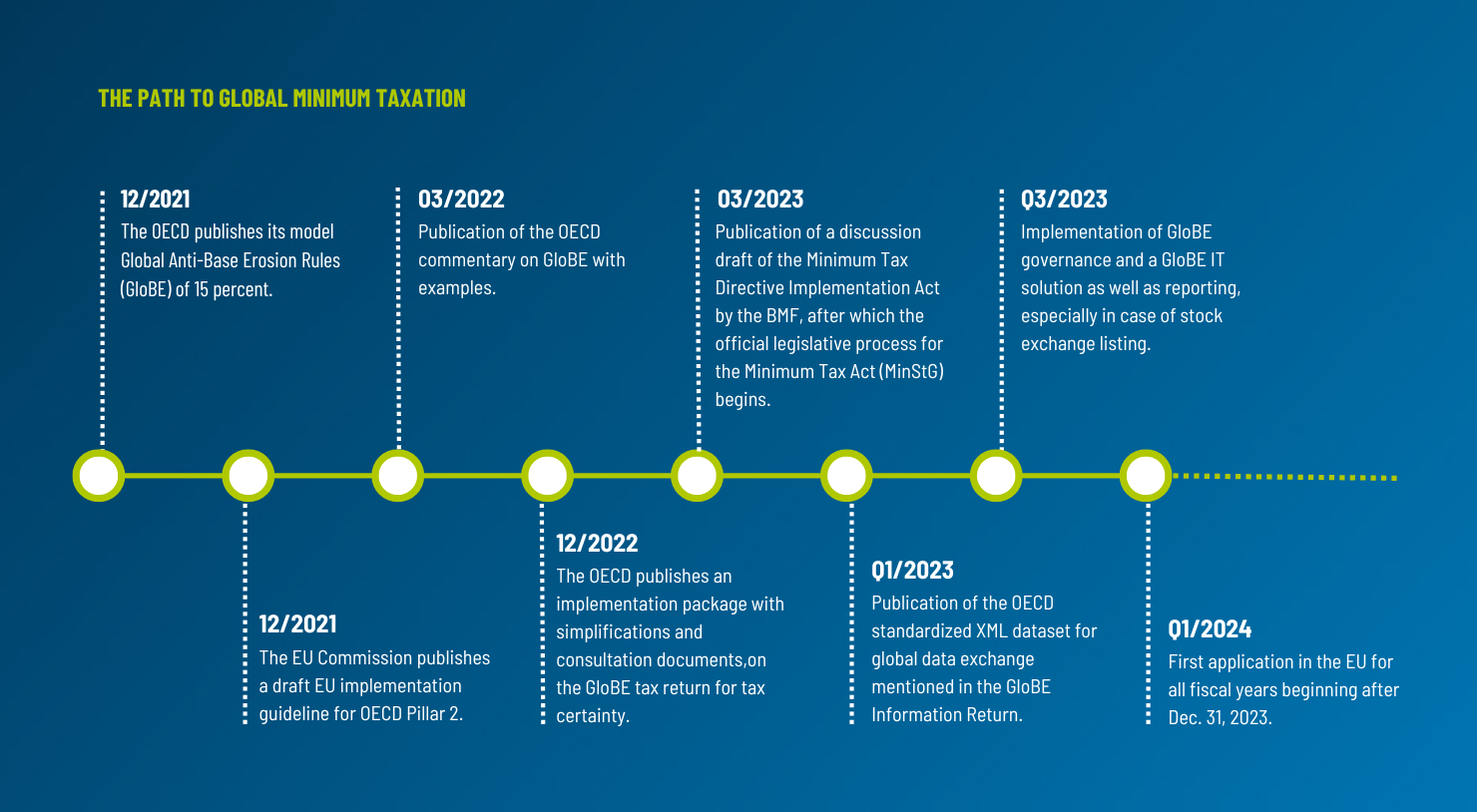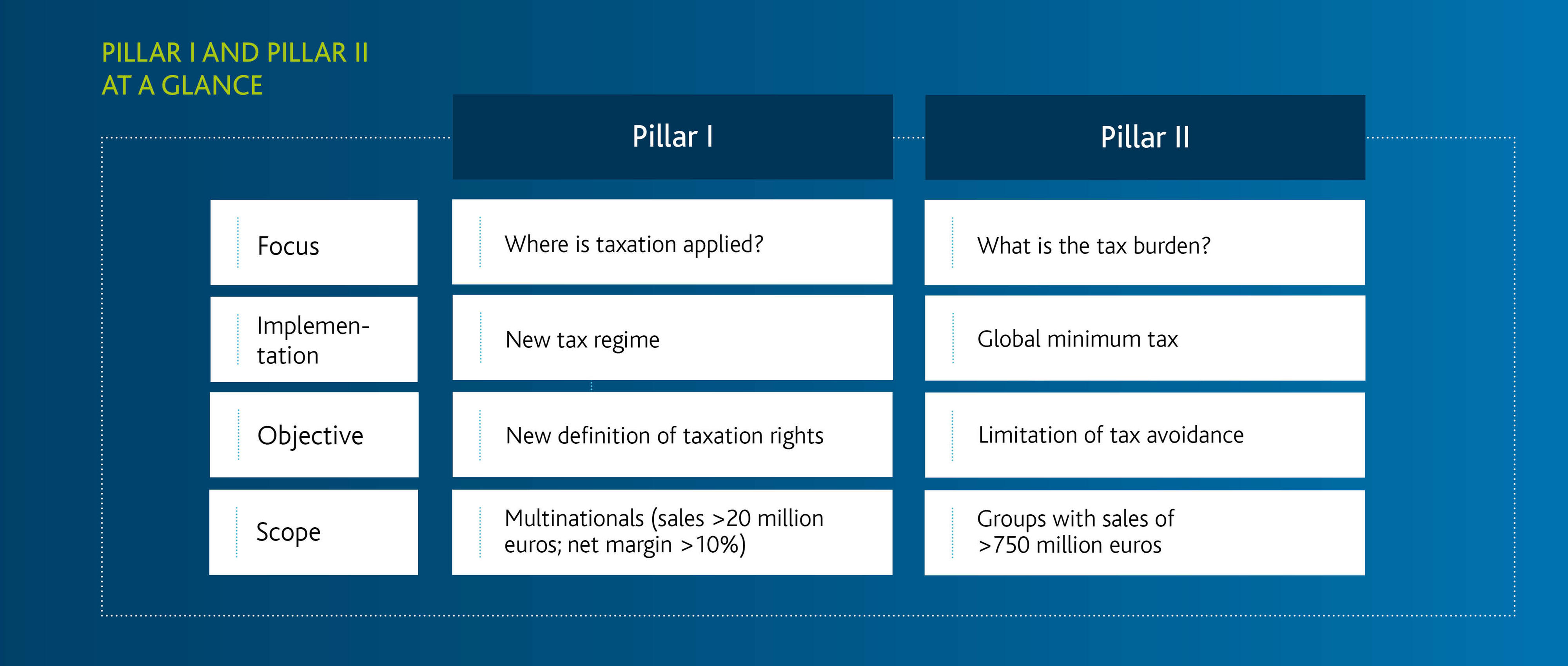
Minimum Taxation According to Pillar II
Challenges and Need for Action
Since the beginning of March 2023, tax experts in German corporate groups have had certainty: the legislator wants to introduce the minimum taxation envisaged by the OECD as the second pillar (Pillar II) of the global GloBE tax reform (Global Anti-Base Erosion Rules) from January 1, 2024, also for domestic corporate groups.
A corresponding draft law, which is largely based on the OECD guidelines, was published by the BMF for discussion on March 20, 2023. In principle, all multinational groups and domestic groups whose group sales exceed EUR 750 million in two of the four preceding years are affected by the new regulations on minimum taxation. The starting point for this legislative initiative was the majority decision of the global OECD member states to ensure greater tax justice with a package of measures aimed at tax avoidance. The so-called Minimum Tax Directive Implementation Act (MinBestRL-UmsG) affects around 800 corporate groups in Germany alone.

Pillar II: What Do the Legal Anchors in the EU Directive Mean for Listed EU Groups?
In October 2021, almost 140 member countries OECD agreed against profit shifting and shortfall (BEPS) on a reform of international corporate taxation. The second pillar of this reform will be introduced for groups of companies with a minimum corporate tax rate of at least 15%. This 2nd pillar (Pillar II) is now legally anchored by an EU directive that was unanimously adopted by all member states. All listed EU groups will need a Pillar II calculation and reporting process from 01.01.2024 at the latest (or from the 2024/2025 financial year). Suppose it is determined that a tax-relevant group entity does not meet the minimum tax rate, taking into account specific adjustment entries. In that case, the supplementary tax amounts must be allocated to the group parent. This company then acts as the sole tax debtor vis-à-vis the tax office, with the business units whose supplementary tax amounts are given to the group parent being jointly and severally liable.

New Rules Equal New Terminology
The already broad regulatory environment of cross-border income taxation is made even more complex by introducing new terms. As mentioned, the new minimum tax calculation introduced several new tax-specific technical terms, e.g.:
- Constituent Entity
- Covered Tax
- ETR (Effective Tax Rate)
- Qualified Domestic Minimum Top-Up Tax Calculation
- Qualified Domestic Minimum Top-Up Taxes
- Top-Up Tax
- Transitional and Permanent Safe Harbours
- Transitional Penalty Relief
How Can CFOs and Tax Departments Overcome the Technological and Process Challenges of Pillar II Reporting?
There are numerous challenges for the CFO organization, particularly the tax department in close cooperation with the IT department, are numerous.
Once the new regulations are understood at the current status - future changes are likely - by those responsible in the business groups, the first priority is to identify the requirements for the technology needed to collect, aggregate, and process the required information.
Suppose the existing EPM solutions (Enterprise Performance Management) or the Group Reporting Tool currently in use cannot be used. In that case, the introduction of tax-specific tools or the onboarding of a service provider may be indicated. Large consulting firms with tax expertise are currently happy to come into play as contacts.
However, corporate groups whose financial platforms for preparing consolidated financial statements reach all investees - and can thus form the basis for the new Pillar II reporting - are clearly at an advantage. It must be considered that, analogous to country-by-country reporting (CbCR), joint ventures, holding companies, subsidiaries not consolidated due to materiality, and permanent establishments must also be considered. Therefore, the cooperation mode between Group Accounting and the tax department must therefore be further deepened.
Need for Action in the Short Term Admits
A forward-looking estimate of the effects of minimum taxation is already due in 2023 so that it can be included in the preparation of the financial statements as of December 31, 2023.
In view of this finding, the financial community is already showing concern. Experts see the accounting of deferred taxes for the reconciliation of consolidated tax expense as being on uncertain ground. In response, the IASB (International Accounting Standards Board), which is responsible for IFRS accounting, published short-term amendments to IAS 12 in November 2022. The scope of this accounting standard is to be extended to include a temporary exception. Accordingly, a group of companies should neither recognize nor have to disclose information on deferred tax assets/liabilities in connection with Pillar II income taxes for a transitional period.
In addition to the design of the processes for data procurement, content-related training for employees must ensure that they can act with confidence, and tax compliance must be ensured by means of manuals and corresponding instructions for action.
Safe Harbour: Transitional Rules Can Provide Relief
The BMF's discussion draft also includes the so-called safe harbor regulations published by the OECD, some of which are limited in time. The supplementary tax is reduced to zero if their requirements are met by proving specific defined tests; the supplementary tax is reduced to zero. However, the obligation to submit the minimum tax report and the tax return remains in this case - and thus also the actual reporting effort.
However, to use transitional rules, a functioning country-by-country reporting (CbCR) system must be in place to use transitional rules.
Written by
